Firstly, try to stay calm. Getting constipated and soiling their clothes isn't something your child is doing on purpose, so there's no reason to get cross with them. Staying positive and relaxed is the best attitude to help your child and praising positive steps is important.
If your child is potty training, they may be feeling anxious or stressed about using the toilet. This can cause them to hold in their poo and lead to constipation. Give your child plenty of time to use the toilet while they are still learning. Encourage them when they do use the toilet. Some parents find a reward chart works. If you think your child is having difficulty with toilet training, you can also chat to your health visitor.
If your child remains constipated despite the advice above, speak to their GP who can decide if they need medicines. The treatment for constipation depends on your child’s age. The longer your child is constipated, the longer it can take to get back to normal. Make sure you get help early.
If your child develops new or more severe tummy ache please click here.
If you child is vomiting please click here.
You should also see your GP if your child is
- losing weight
- tired
- or has blood or mucus in their stools.
Laxatives are often recommended for children, alongside diet and lifestyle changes. It may take several months for the treatments to work. Keep trying until they do. Remember that laxative treatment may make your child's overflow soiling worse for a time before it gets better so consider the impact, for example on school trips.
Once your child's constipation has improved, your GP may advise that your child keeps taking laxatives for a while to make sure their poo stays soft enough to push out regularly. The medicines are safe and don’t cause a lazy bowel.
However, if your child is experiencing significant pain or regularly soiling their pants, despite being on treatment, you should take them back to see your GP.





